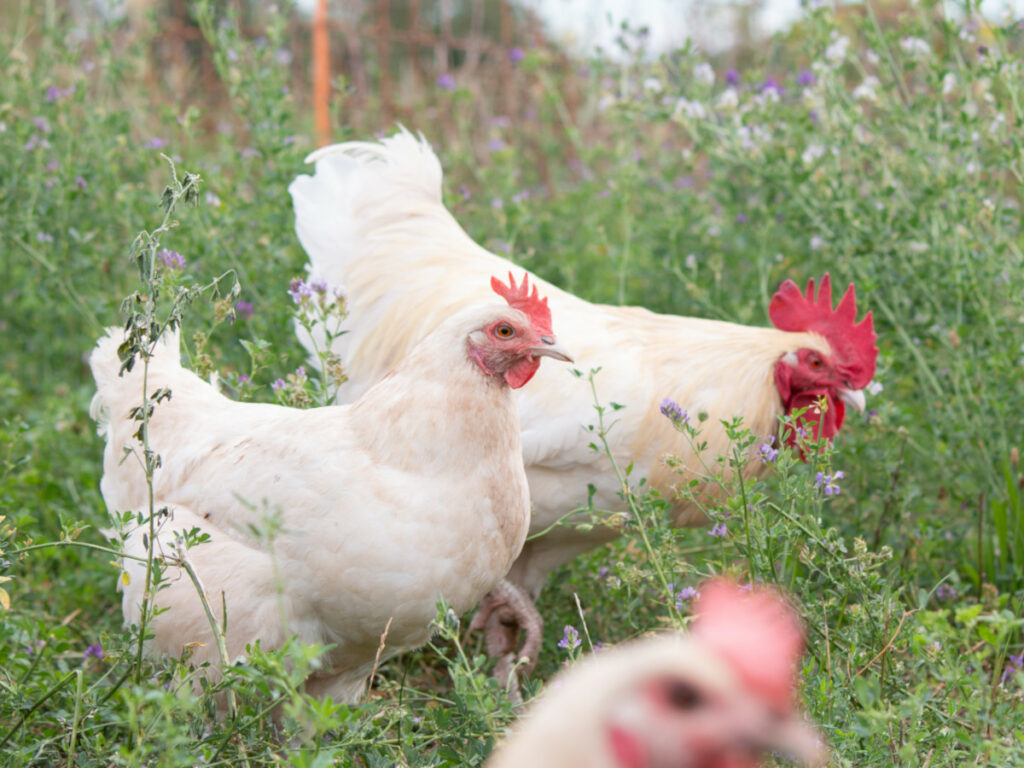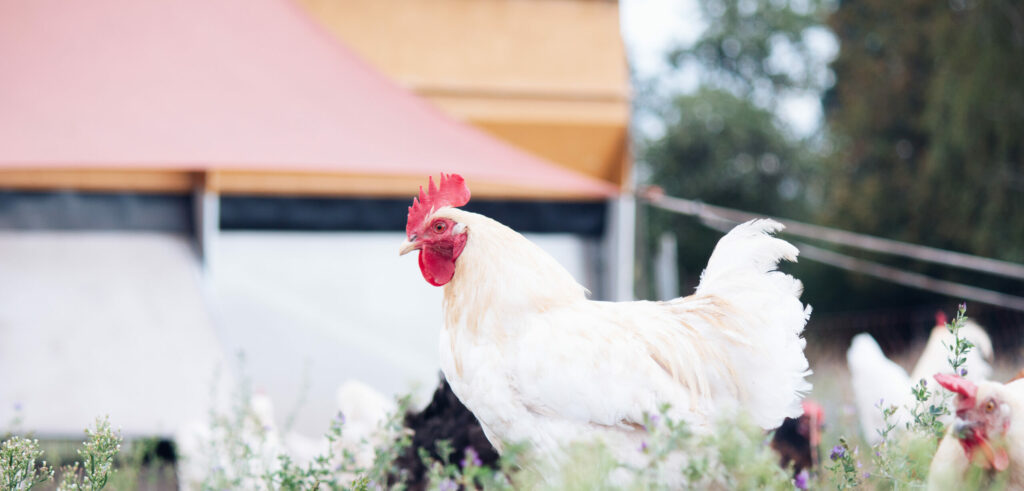Foto: Eva Wolf | Demeter
ÖTZ Cream are classic Dual-purpose chickenDas Zweinutzungshuhn bezeichnet Zuchtlinien, die sowohl für die Eierproduktion als auch für die Fleischgewinnung geeignet sind. Im Gegensatz zu spezialisierten Hochleistungstieren – bei denen entweder auf hohe Legeleistung (Legehennen) oder schnelles Fleischwachstum (Masthähnchen) gezüchtet werden – bietet das Zweinutzungshuhn eine Möglichkeit beide Eigenschaften in einem Tier zu vereinen. Da jedoch keine Spezialisierung vorliegt, sind die Leistungen bei Ei und Fleisch ausgeglichen und in der Regel etwas geringer, als die Leistungen von spezialisierten Tieren.. They are the result of crosses between the two breeds Bresse Gauloise and White Rock. ÖTZ Cream cocks and hens have white plumage and colorful feet. The colors of the feet range from cream and beige to the blue-grey feet typical of Bresse Gauloises.
Utility crossingIn animal breeding, commercial crossbreeding refers to the targeted crossing of animals of two different breeds or breeding lines in order to combine the positive characteristics of both parents in the offspring. The aim is usually to improve characteristics such as health, performance or adaptability.
White Rock x Bresse Gauloise
Bresse Gauloise x White Rock
White with colorful feet
Hatching eggs and chicks all year round | pullets on pro order
yes
Certified in accordance with the EU Animal Health Regulation (BmTierSSchV) and therefore approved for trade in EU-certified hatcheries and abroad.

| Parameters | Performance |
|---|---|
| Optimum laying performance in 52 weeks | 250 Eggs |
| Shell colour | light brown/beige |
| Target weight at the start of laying period | 2.0 kg |
| Weight End of 1st laying period | Living weight 2.4 - 2.8 kg Slaughter weight 1.3 - 1.6 kg |
| Ø Feed consumption 1st laying period | 135 - 145 g / animal and day |

| Parameters | Performance until day 98 (end of 14th week) | Performance Until day 112 (end of 16th week) |
|---|---|---|
| Living weight of the cocks* | 2.3 kg | 2.6 kg |
| Cannibalization rate* | 68 % | 70 % |
| Ø Increase* | 23.0 g | 23.0 g |
| Ø Feed conversion* | 3,6 | 3,7 |
| *with the following feeding: Week 1-6: Energy 11.1 MJ/kg, XP:18,2 % Methionine: 0.38% Week 7-16: Energy 10,9 MJ, XP: 16,4%, Methionine: 0,32% |
||
Dual-purpose cocks are much more active than usual broilers.
The housing set-up should take into account the animals' willingness to move in order to prevent the occurrence of breast blisters and other injuries. Straw bales and raised levels are suitable for structuring the hutch, but also provide good resting areas for lower-ranking animals. From the 10th week of life, apart from daylight, additional light in the house is superfluous and should be switched off in favor of the calmer animals.
You need to load content from reCAPTCHA to submit the form. Please note that doing so will share data with third-party providers.
More InformationYou are currently viewing a placeholder content from Google Maps. To access the actual content, click the button below. Please note that doing so will share data with third-party providers.
More Information